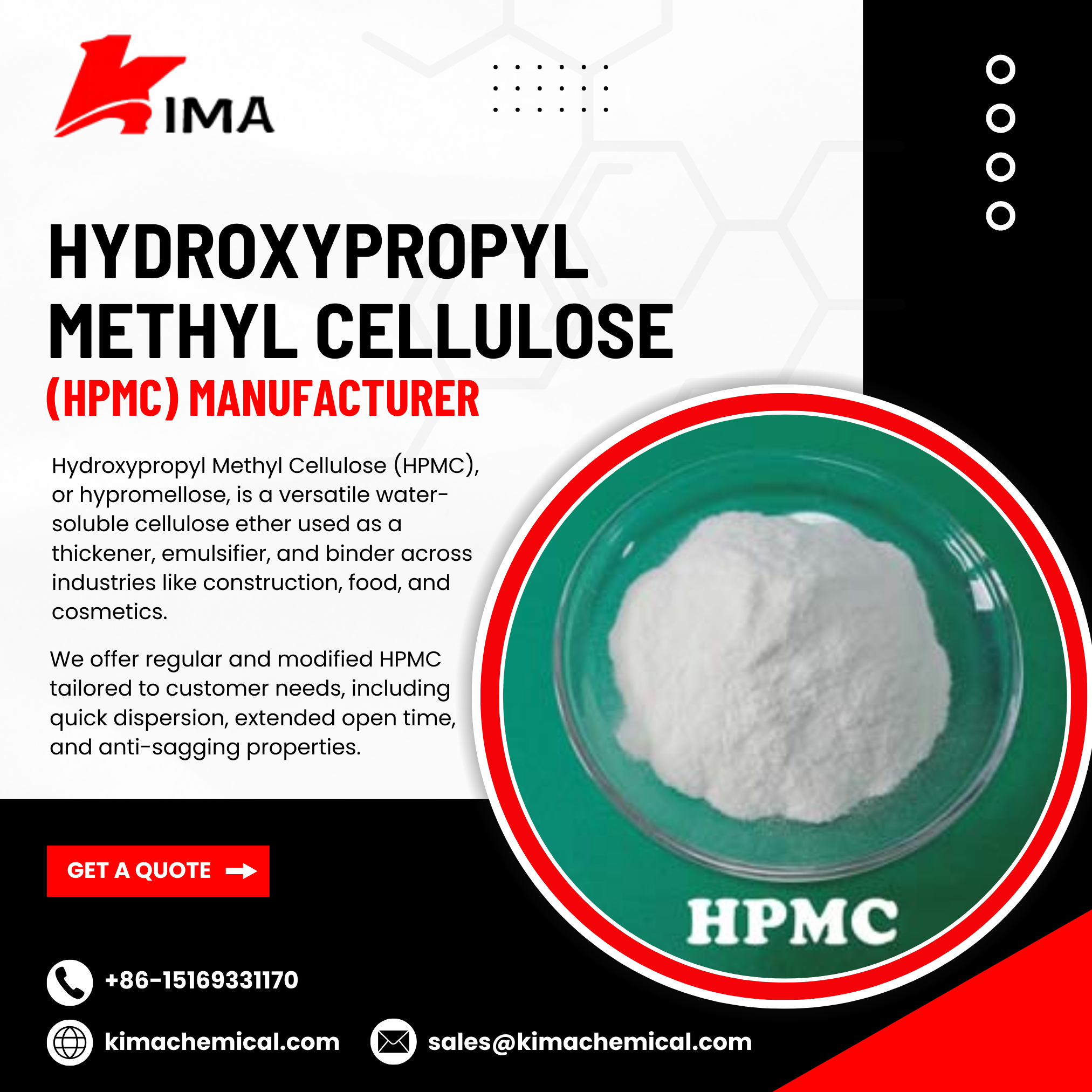Kima Chemical: A Leader in HPMC Manufacturer
Innovation, Quality, and Sustainability in Cellulose Ether Production
1. Introduction to Hydroxypropyl Methylcellulose (HPMC)
Hydroxypropyl Methylcellulose (HPMC), also known as hypromellose, is a semi-synthetic, inert polymer derived from cellulose. As a non-ionic cellulose ether, it is renowned for its versatility, biodegradability, and biocompatibility. HPMC exhibits critical properties such as thermal gelation, water retention, film-forming, and thickening, making it indispensable across industries like pharmaceuticals, construction, food, and cosmetics.
The global HPMC market, valued at approximately $1.5 billion in 2023, is projected to grow at a CAGR of 7.5% through 2030, driven by demand in emerging economies and sustainable material trends. Kima Chemical has positioned itself as a key player in this dynamic market, leveraging advanced technology and a customer-centric approach.
2. Kima Chemical Company Overview
History and Evolution
Founded in 2015 in Shandong, China, Kima Chemical began as a hpmc manufacturer of cellulose derivatives. Over two decades, it expanded its portfolio to specialize in HPMC, establishing state-of-the-art facilities in Shandong provinces. With a workforce of over 200 employees, Kima serves clients in 50+ countries, emphasizing innovation and sustainability.
Mission and Vision
Kima’s mission is to deliver high-performance HPMC solutions while minimizing environmental impact. Their vision includes becoming a global leader in sustainable cellulose ether production by 2030, supported by continuous R&D investment and strategic partnerships.
Certifications and Compliance
Kima holds ISO 9001 (Quality Management), ISO 14001 (Environmental Management), and OHSAS 18001 (Occupational Health and Safety) certifications. It complies with pharmacopeial standards (USP, EP) for pharmaceutical-grade HPMC, ensuring global acceptability.
3. Manufacturing Process and Quality Control
Raw Material Sourcing
Kima sources wood pulp from sustainably managed forests in Scandinavia and Canada, ensuring traceability and eco-friendly practices. Strict supplier audits guarantee raw material purity and consistency.
Production Process
- Alkalinization: Wood pulp is treated with sodium hydroxide to produce alkali cellulose.
- Etherification: Reacted with methyl chloride and propylene oxide to introduce hydroxypropyl and methyl groups.
- Purification: Residual chemicals are removed via washing and neutralization.
- Drying and Milling: Processed into fine powder or granules, tailored to client specifications.
Quality Assurance
Kima’s labs use HPLC, GC, and viscometers to test viscosity, methoxyl/hydroxypropyl content, and particle size. Each batch undergoes microbiological testing for pharmaceutical grades. Real-time monitoring ensures process stability, while a 100% traceability system allows recalls if needed.
4. Applications of Kima’s HPMC
Pharmaceuticals
- Tablet Coating and Binding: Provides controlled drug release and moisture resistance.
- Ophthalmic Solutions: Used in artificial tears for lubricity.
- Topical Gels: Enhances viscosity and stability.
Construction
- Cement Additives: Improves workability and water retention in mortars.
- Tile Adhesives: Enhances adhesion and open time.
- Gypsum Products: Reduces cracking in plasters.
Food Industry
- Thickening Agent: Used in sauces and dairy products.
- Stabilizer: Maintains texture in gluten-free baked goods.
Cosmetics
- Emulsion Stabilizer: In creams and lotions.
- Film-Forming Agent: For hair sprays and masks.
Other Uses
Paints, ceramics, and agriculture (seed coatings).
5. Research and Development
Kima allocates 5% of annual revenue to R&D, focusing on:
- Customized HPMC Grades: Tailored viscosity and solubility for niche applications.
- Sustainable Production: Reducing energy use via enzymatic modification trials.
- Collaborations: Partnerships with MIT and University of Shanghai for nanotechnology integration.
Recent breakthroughs include a low-viscosity HPMC for injectable drug formulations and a temperature-sensitive grade for 3D printing mortars.
6. Sustainability and Environmental Responsibility
- Green Manufacturing: Closed-loop water systems and biogas-powered dryers reduce CO2 emissions by 30%.
- Waste Management: Byproducts like sodium sulfate are recycled for detergent production.
- Community Initiatives: Reforestation projects and STEM scholarships in local communities.
Kima aims to achieve carbon neutrality by 2035 through solar energy adoption and biomass sourcing.
7. Global Presence and Market Reach
Kima exports to North America, Europe, Southeast Asia, and Africa. Regional warehouses in Germany, the U.S., and India ensure timely delivery. Clients include Fortune 500 companies like Pfizer and LafargeHolcim.
Case Study: A collaboration with a European pharmaceutical firm resulted in a patented HPMC-based extended-release tablet, reducing production costs by 20%.
8. Future Outlook and Strategic Goals
- Capacity Expansion: New plant in Vietnam (2025) to cater to ASEAN demand.
- Product Diversification: Entering the nutraceutical and personal care markets.
- Digital Transformation: AI-driven predictive maintenance and blockchain for supply chain transparency.

Kima Chemical exemplifies excellence in HPMC manufacturing through innovation, quality, and eco-conscious practices. As industries increasingly prioritize sustainability, Kima is poised to lead the cellulose ether market, driven by strategic investments and a commitment to global standards.
